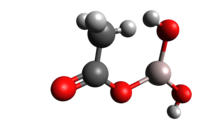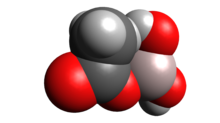Aluminium monoacetate
Aluminium monoacetate, also known as dibasic aluminium acetate, and formally named dihydroxy aluminium acetate, is a salt of aluminium with acetic acid. It is an organometallo containing aluminium that has an oxidation state of 3+ in the chemical formula (HO)2AlCH3CO2,and under standard conditions it appears as white solid powder.[1]
 | |
 | |
 | |
| Names | |
|---|---|
| IUPAC name
Aluminium monoacetate | |
| Other names
Basic aluminium monoacetate
Dihydroxyaluminum acetate | |
| Identifiers | |
3D model (JSmol) |
|
| ChEMBL | |
| ChemSpider | |
PubChem CID |
|
| UNII | |
CompTox Dashboard (EPA) |
|
| |
| |
| Properties | |
| (HO)2AlCH3CO2 or C2H5AlO4 | |
| Molar mass | 120.04 g/mol |
| Appearance | White powder |
Except where otherwise noted, data are given for materials in their standard state (at 25 °C [77 °F], 100 kPa). | |
| Infobox references | |
Chemistry
Aluminium monoacetate is prepared by the diformate, Al(OH)(O2CH)2 • H2O, crystallizing from a concentrated solutions of newly precipitated Al(OH)3 in formic acid. With an excess of the acid, Al(O2CH)3 • 3H2O crystallizes.[2]
Reaction in which Aluminium monoacetate is involved: Al(OH)(CH3COO)2 + H2O → Al(OH)2(CH3COO) + CH3COOH[3]
Uses
Aluminium monoacetate is a dermatological agent used as an antiseptic and astringent.[4] It is used as an antiseptic to reduce the possibility of infection in minor wounds, cuts, and burns. Specifically, it treats itching, stinging of the infected skin, inflammation, and it promotes healing. It also can be used as a topical astringent to help shrink the body's tissues when applied to the skin as it acts as a protective layer on irritated and inflamed skin.
References
- "Monoacetato di alluminio", Wikipedia (in Italian), 2019-05-29, retrieved 2020-07-19
- Downs, A.J (1993). Chemistry of Aluminium, Gallium, Indium, and Thallium. Bishopbriggs, Glasgow: Chapman & Hall. p. 158. ISBN 075140103X.
- "CharChem. Dihydroxyaluminum Acetate". easychem.org. Retrieved 2020-07-19.
- Triggle, David; Ganellin, C.R. (1997). Dictionary of Pharmacological Agents. Cambridge: Chapman & Hall. pp. 595, 600. ISBN 0412466309.
Acetyl halides and salts of the acetate ion | |||||||||||||||||||
|---|---|---|---|---|---|---|---|---|---|---|---|---|---|---|---|---|---|---|---|
| AcOH | He | ||||||||||||||||||
| LiOAc | Be(OAc)2 BeAcOH |
B(OAc)3 | AcOAc ROAc |
NH4OAc | AcOOH | FAc | Ne | ||||||||||||
| NaOAc | Mg(OAc)2 | Al(OAc)3 ALSOL Al(OAc)2OH Al2SO4(OAc)4 |
Si | P | S | ClAc | Ar | ||||||||||||
| KOAc | Ca(OAc)2 | Sc(OAc)3 | Ti(OAc)4 | VO(OAc)3 | Cr(OAc)2 Cr(OAc)3 |
Mn(OAc)2 Mn(OAc)3 |
Fe(OAc)2 Fe(OAc)3 |
Co(OAc)2, Co(OAc)3 |
Ni(OAc)2 | Cu(OAc)2 | Zn(OAc)2 | Ga(OAc)3 | Ge | As(OAc)3 | Se | BrAc | Kr | ||
| RbOAc | Sr(OAc)2 | Y(OAc)3 | Zr(OAc)4 | Nb | Mo(OAc)2 | Tc | Ru(OAc)2 Ru(OAc)3 Ru(OAc)4 |
Rh2(OAc)4 | Pd(OAc)2 | AgOAc | Cd(OAc)2 | In | Sn(OAc)2 Sn(OAc)4 |
Sb(OAc)3 | Te | IAc | Xe | ||
| CsOAc | Ba(OAc)2 | Hf | Ta | W | Re | Os | Ir | Pt(OAc)2 | Au | Hg2(OAc)2, Hg(OAc)2 |
TlOAc Tl(OAc)3 |
Pb(OAc)2 Pb(OAc)4 |
Bi(OAc)3 | Po | At | Rn | |||
| Fr | Ra | Rf | Db | Sg | Bh | Hs | Mt | Ds | Rg | Cn | Nh | Fl | Mc | Lv | Ts | Og | |||
| ↓ | |||||||||||||||||||
| La(OAc)3 | Ce(OAc)x | Pr | Nd | Pm | Sm(OAc)3 | Eu(OAc)3 | Gd(OAc)3 | Tb | Dy(OAc)3 | Ho(OAc)3 | Er | Tm | Yb(OAc)3 | Lu(OAc)3 | |||||
| Ac | Th | Pa | UO2(OAc)2 | Np | Pu | Am | Cm | Bk | Cf | Es | Fm | Md | No | Lr | |||||